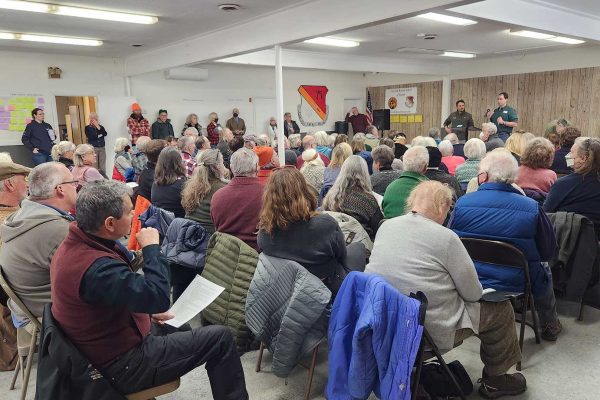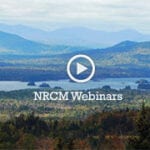The Natural Resources Council of Maine supports a proposed offshore wind (OSW) port on Sears Island because it is our best chance to create a new clean energy industry for Maine that helps us become more energy independent, reduce harmful air pollution, and create thousands of new good-paying jobs.
In this post, we explain the reasoning behind our support for the State of Maine’s proposal to develop an Offshore Wind Port on Sears Island, based on data from the recently released Pre-Application Alternatives Analysis for a State of Maine Offshore Wind Port (alternatives analysis).
The State’s in-depth analysis of two potential locations – Mack Point and Sears Island, both located in Searsport — demonstrates clearly that Sears Island is the most viable location for a port for the following reasons:
- Avoids Unnecessary Costs for Taxpayers: The Sears Island location could cost half as much as the Mack Point site ($555 million for Sears Island, compared with potentially more than $1.1 billion for Mack Point).
- Provides Greater Operational Efficiency, Flexibility, and Adaptability: The Mack Point site would require significant dredging and involves operational and site control constraints (e.g., uncertainty over a rail line), that could increase costs further, result in construction delays, and/or prevent the site from being able to function successful as technology evolves.
Supporting a preferred location for an offshore wind port is not a decision NRCM takes lightly. As a science-based organization, any such decision we make must be based on the best available data, a careful analysis of alternative site locations, and a clear-eyed view that we must sometimes make tough choices. This is one such case, and it is essential in order to build the infrastructure necessary to unlock the homegrown clean energy sources that will reduce our dependence on expensive and unreliable oil and gas. That is the approach that NRCM has taken to this issue.
As we move toward a fully renewable electric grid that powers our homes, businesses, cars, and trucks, we have to think about what we want Maine’s future to look like. For us that means delivering on the promise of clean air and water, healthy communities and healthy wildlife, and a commitment to ensuring that the benefits flow equally to all Mainers. Offshore wind, enabled by an offshore wind port, presents one of the greatest opportunities we have to deliver on this need.
Unlocking the Greatest Clean Energy Opportunity We’ve Ever Seen
 Offshore wind represents a rare chance to create a new clean energy industry that is built on Maine talent, ingenuity, and hard work, and reflects the proud ship-building and maritime heritage of our past and our present.
Offshore wind represents a rare chance to create a new clean energy industry that is built on Maine talent, ingenuity, and hard work, and reflects the proud ship-building and maritime heritage of our past and our present.
The winds in the Gulf of Maine are some of the strongest and most consistent in the world. Taking advantage of just a fraction of this renewable resource has the potential to generate about half the clean, reliable energy we’ll need to power the future.
Maine’s offshore wind law and the state’s Offshore Wind Roadmap provide a blueprint for doing this responsibly so we can protect wildlife, avoid critical fishing grounds, and deliver tangible, long-lasting benefits to local communities.
No one disputes the fact that to take advantage of the economic and environmental benefits of offshore wind, Maine must develop a port.
The floating offshore wind platforms and turbines that will be used in the Gulf of Maine’s deep ocean waters are large. They will need to be constructed and assembled in a port before being towed out and moored in their final locations 30 to 50 miles offshore. That means floating offshore wind ports have specific requirements:
- A long, straight wharf for unloading turbine components, launching platforms, and assembling turbines;
- A wide, deep-water channel to the open ocean;
- Space for platform manufacturing and component storage; and
- No overhead obstructions.
Nearly all of the jobs and economic benefits from developing a floating offshore wind industry will come from hosting an offshore wind port in Maine at one of the sites that meets these criteria.
These criteria are so strict, and suitable sites so few and far between, that the next nearest place outside of Maine that is being evaluated for an offshore wind port where floating turbines could be built and assembled is in southwest Virginia.
Because of these unique constraints, failing to build or delaying the construction of an offshore wind port in Maine would hold us back from realizing the climate, health, and economic benefits that offshore wind will bring.
Thoughtful Site Selection Process
The State of Maine’s Alternatives Analysis describes in great detail the extensive, years-long process the Maine Department of Transportation (MDOT) went through to choose Sears Island as the location for Maine’s port.
A total of 23 potential locations in Maine were evaluated based on the criteria above. Seven locations were selected for greater scrutiny, but only two locations emerged as potentially viable. These two sites – Mack Point and Sears Island — both located in Searsport, were evaluated individually and against each other as potential alternatives.
- Mack Point is an existing oil and bulk cargo terminal owned by a large corporate energy company.
- Sears Island is an island owned by the State with a third of the island designated for development as a deep-water port, and the other two-thirds permanently protected as conservation land.
The Alternatives Analysis also considered a proposal put forward by Sprague Energy, the private owner of the existing Mack Point Terminal. That proposal failed to meet fundamental requirements for a successful port due to multiple operational and practical concerns involving a problematic port layout and crane location, uncertainty caused by rail crossings, extensive dredging requirements, insufficient wharf loading capacity, and other deficiencies that are detailed in the alternatives analysis. Rather than assessing Sprague’s proposal in full, MDOT instead used an optimized Mack Point alternative as the best option for final comparison.
MDOT provides a clear foundational statement that guided the alternatives analysis, which involved in-depth consultant-based research and evaluation:
“Impacts to the natural environment are unavoidable for a project of this scope and significance, and the State has weighed several factors into its identification of Sears Island as the most preferred alternative. Of primary importance is the development of an efficient and versatile port facility that is worthy of the significant financial investment estimated between $500 million and $750 million — and attractive to future OSW developers over the useful 50-year design life of the port.”
Operational and Viability Concerns about Mack Point
The Alternatives Analysis identified several deficiencies with the optimized Mack Point site that substantially increase the cost of this option, reduce its viability, and thus significantly diminish its likelihood of meeting the port requirements that are necessary for success:
- Rail Removal. The Mack Point site is crossed by the Canadian Pacific–Kansas City rail line, which would have to be removed. At this time, it is unclear whether removal of this line is possible, as there is no indication whether the owner would consent to removal of the line. The uncertainty and additional approvals associated with removal of the line could also cause significant construction delays, or possibly derail the port project entirely. Sears Island does not have this issue.
- Dredging. To utilize Mack Point as a port, there would have to be a significant amount of dredging (approximately 15 acres) in Searsport Harbor. Previous efforts to dredge in this harbor have faced strong opposition from lobstermen, residents, and conservation organizations who were rightly concerned about the potential of mobilizing contaminants located in the sediments. The potential costs and environmental impacts of dredging would be significant for the Mack Point site. Disposal of a high volume of dredged sediment at sea or on land would raise additional cost and environmental impact concerns. The Sears Island proposal does not require dredging.
- Navigation, Marine Safety, and Operational Efficiency. Due to its orientation, the wharf at Mack Point is more exposed to prevailing swells and weather conditions. This would increase navigation risks for ships bringing in and unloading offshore wind components. During certain weather conditions, operations may have to be postponed, adding time and cost to the construction of offshore wind projects, which would be passed on to ratepayers. These additional operation concerns and costs would be avoided at Sears Island.
- Taxpayer Cost. Due to dredging and other factors, the construction costs for Mack Point alone would be significantly higher than at Sears Island, but the biggest difference comes from the cost of leasing Sprague’s private facility at Mack Point for hundreds of millions of dollars over the lifetime of the port.
Because the Sears Island site is owned by the State of Maine, this option would involve no lease payments. To the contrary, the Sears Island site might be able to generate revenue from lease payments from offshore wind companies involved in the project.
With the lease payments and other anticipated costs taken into consideration, the Mack Point option would cost more than twice the cost of the Sears Island option, with Mack Point estimated to cost between $921 million and $1.134 billion, compared with a cost for the Sears Island option of an estimated $555 million.
Sears Island is the Most Effective Location for an Offshore Wind Port
Maine needs an offshore wind port that can fully support a new offshore wind industry, create the most climate and economic benefits, minimize local environmental impacts, and be constructed and operated at a reasonable cost.
The siting of Maine’s offshore wind port is a difficult issue and one that NRCM has been wrestling with for months. We appreciate the feedback we have received from many of our members and supporters about the issue.
NRCM policy experts evaluated this issue as we do all our issues — based on facts and the latest science, while weighing multiple criteria. NRCM staff have visited both the Mack Point and Sears Island sites multiple times and talked with experts in the offshore wind industry and port operations. We evaluated information from both Sprague and MDOT, and we have carefully reviewed the alternatives analysis — which we find to be professional and persuasive.
Based on this data-driven approach, we conclude that Sears Island will be the most effective site for an offshore wind port that can be constructed in a timely and successful manner, while containing costs and minimizing environmental impacts to the extent possible.
Development of a port on State-owned land that already is zoned for commercial development on Sears Island provides the best path forward for the development of offshore wind in the Gulf of Maine — the most significant clean energy opportunity that the state of Maine has ever had.
Although the data shows that Mack Point is unsuitable as the location for Maine’s central investment in an offshore wind port facility, there remains a possibility that Mack Point could play a valuable supporting role in a future offshore wind industry in Maine. This role could involve the delivery and storage of equipment like anchors and cables and other subsea equipment; operations and maintenance activities; construction of platform or turbine components; and other support for offshore wind projects and activities.
Moving Forward with an Offshore Wind Port for Maine

We cohosted a Searsport community meeting about offshore wind and an offshore wind port in Searsport earlier this year (JCaldwell/NRCM)
The State of Maine is expected to submit a permit application for the Sears Island offshore wind port later this year or in early 2025. This will trigger a multi-year permitting and review process, with extensive opportunities for public input, further expert analysis, and ongoing assessment, involving the Town of Searsport, state and federal agencies, and interested parties.
As this proposal moves into the permitting process, NRCM will continue to be fully engaged to ensure that Maine’s offshore wind port brings the greatest possible benefit to Maine communities and our environment with the lowest impacts.
We will continue to work with our partners in the environmental and labor communities to encourage state and federal governments to improve outreach and engagement with the Wabanaki Nations to ensure that their culture, history, and perspectives are incorporated into planning.
We recognize that developing a port on Sears Island will have significant site impacts and visual impacts. We also recognize that climate change has put society in the necessary position of needing to rapidly reduce the combustion of fossil fuels that are fueling the flooding, extreme weather, and heat waves that are harming our health, endangering our woods and wildlife, and damaging Maine’s inland and coastal communities.
Moving forward, we’ll continue visiting Mainers in the Midcoast and elsewhere to listen and learn from them. The Climate & Clean Energy team just wrapped up three local conversations with residents in towns up and down the coast, and has participated in several events in the Searsport area already. We know that this work needs to be done in the community, and we’re committed to continuing that important outreach work.
We respect those with strong feelings on this issue. Across the nation, states are facing hard decisions about how to achieve the biggest transformation of our energy systems in more than 100 years. For NRCM, proceeding with the development of an offshore wind port on Sears Island is one of those difficult decisions. We believe that the Alternatives Analysis provides the in-depth analysis necessary so that Maine can be confident proceeding with the chosen site of Sears Island as the location that holds the highest prospect for success.
—Jack Shapiro, NRCM Climate & Clean Energy Director











Leave a Reply